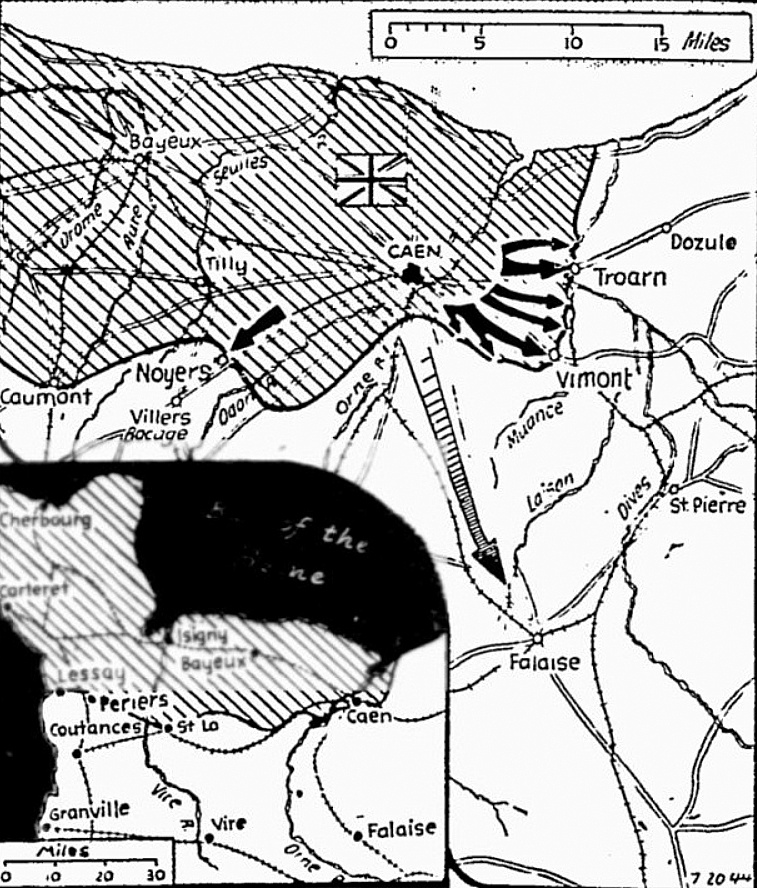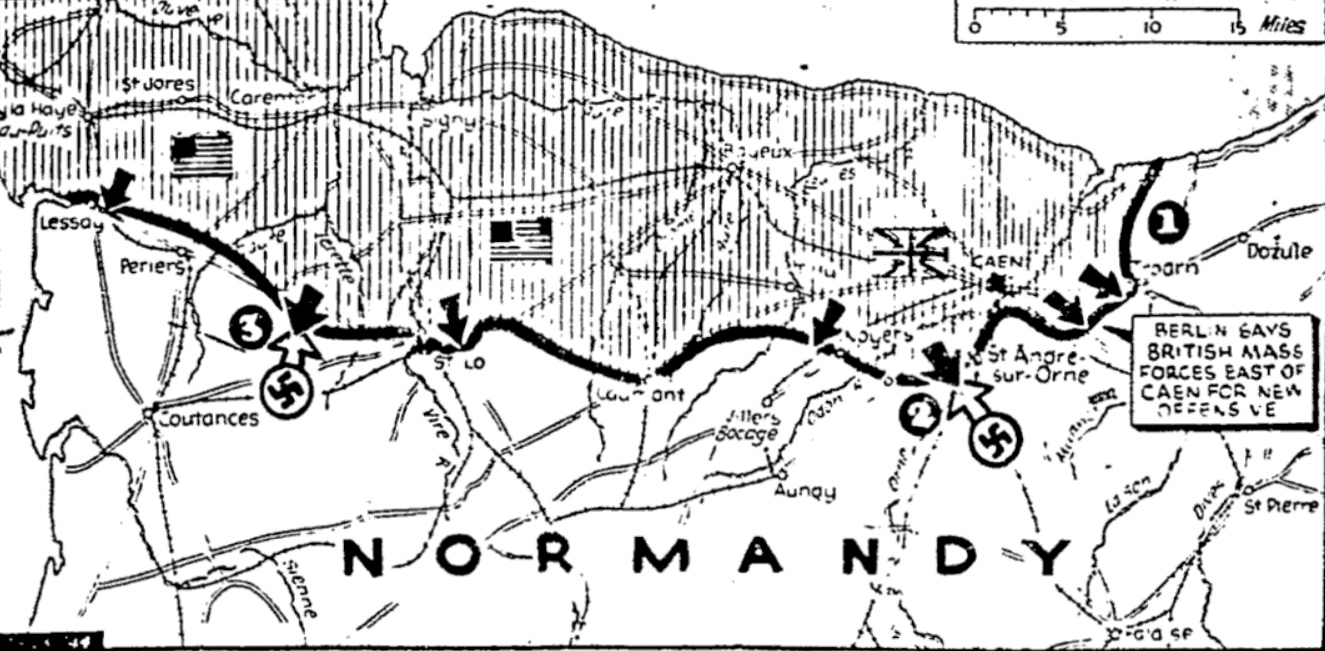The Pittsburgh Press (July 20, 1944)
British storm two more cities in Normandy
Tanks smash forward down Paris road
Battling into two towns, British armored forces had thrust eight miles beyond Caen today. Street battles were being fought in Vimont and Troarn and the British were reported massing forces for a drive toward Falaise. On the American sector of the front (inset map), the Yanks were mopping up in the Saint-Lô area.
SHAEF, London, England (UP) –
The British 2nd Army, hammering out a steadily expanding Normandy breakthrough arc, drove through nine more towns today, stormed into the streets of Troarn and Bourguébus, and sent a spearhead down the Paris road to Vimont, eight miles southeast of Caen.
Many scores of Allied Sherman tanks were smashing through the network of German fortifications on the Caen plain in wild battles of armor against the Nazis who had now massed at least five and a half divisions in a frantic effort to stem the march inland.
Allies smash on
United Press writer Richard D. McMillan reported that British and Canadian assault forces stormed six more villages in the area of the breakthrough. Whether they supplemented or duplicated the nine announced at Supreme Headquarters was not certain.
The German Transocean News Agency said U.S. and Canadian Army forces under Lt. Gen. George S. Patton had gone into action on the Normandy front. Gen. Dwight D. Eisenhower’s headquarters had no comment.
Inside the battle arc, lying an average of four miles from Caen – with advanced positions at Troarn, seven miles to the east, and Vimont, eight miles to the southeast – the British and Canadian troops captured Ifs, Cormelles, Bras, Hubert-Folie, Soliers, Four, Le Poirier, Cagny and Grentheville.
Stiff fight at Troarn
Allied infantry and tanks consolidated their grip on the nine villages while Gen. Sir Bernard L. Montgomery’s armor wove through the no-man’s-land blasting out German strongpoints and turning back enemy thrusts.
The easternmost point of the Allied advance was within 1,000 yards of the river Muance, which flows east of Troarn and forms the first appreciable water obstacle east of the Orne.
The Germans were putting up a stiff fight at Troarn, but the British were bartering in from the west.
On American front
Meager reports from the American front said the 1st Army had completed the mop-up of the Vire River bend northwest of Saint-Lô and established outposts a few hundred yards southwest and southeast of the captured fortress city.
Between Saint-Lô and Caen, the Germans had been forced back below the Caumont–Tilly-sur-Seulles road to a general line about 2,000 yards – more than a mile – beyond it.
Mr. McMillan reported from the Caen front:
Stubborn fighting went on all day, and saw our troops pushing forward into some villages while German long-range batteries lobbed shells over to try to stem the impetus of our infiltrations over the bridges into the slowly widening sector of our advance.
Loop closed on Nazis
British troops bolstering the right wing beat the Germans back steadily in the Noyers sector southwest of Caen, overrunning strategic positions including valuable high ground and capturing the village of Landelles, a mile west of Noyers which was still in German hands.
On the American front, Lt. Gen. Omar N. Bradley’s 1st Army advanced west of Saint-Lô and swung southeast from points northwest of the captured town, closing a loop in which a few German rearguards remained.
Above Saint-Lô, just west of Remilly-sur-Lozon, the doughboys pushed along a tiny stream and captured three villages.
“The battle south and east of Caen continues,” Gen. Dwight D. Eisenhower’s communiqué said.
Rubble-strewn villages
The maximum advance down the trunk highway to Paris carried to Vimont, eight miles below Caen and five miles south of Troarn. Behind the British lay the rubble-strewn ruins of a dozen villages and strongpoints almost blasted out of existence by the impact
The battlefield within the breakthrough area “looks like nothing any soldier ever saw,” Mr. McMillan reported. He quoted a tank crewman as saying:
It seems to us more like a battlefield amidst the craters of the moon. It is really eerie, with its bomb craters, empty villages and pockets of German dead.
Chain of cemeteries
An earlier dispatch from Mr. McMillan said there was still fighting around the villages of Cumerille, Bigerville, Saunderville, Banneville, Campagne and Cagny, because “these places themselves are mortuaries. These villages are like a chain of cemeteries. Happily, it is mainly German dead.”
Once the British capture Troarn and secure the left flank, Gen. Montgomery will be in position to wheel inland to excellent tank country stretching south and southeast as far as Falaise, 20 miles southeast of Caen.
The Normandy weather yesterday and today was described officially as “miserable,” denying the ground forces any big-scale air support. It was better in other parts of France, and Allied planes shot up 27 locomotives and about 200 freight cars in operations extending from Bordeaux to Paris.

